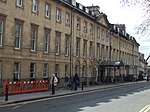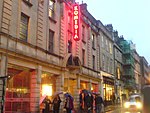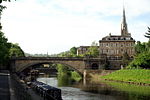Ustinov Studio

The Ustinov Studio is a studio theatre in Bath, England. It is the Theatre Royal's second space, built in 1997 at the rear of the building on Monmouth Street. It is named after the actor Peter Ustinov who led the fundraising programme for the Studio's creation in the early 1990s. In 2006 it closed for a £1.5million, 15-month refurbishment undertaken by Haworth Tompkins. The Ustinov Studio re-opened in February 2008, following a period of closure for refurbishment, with their own production of Breakfast With Mugabe starring Joseph Marcell, Miles Anderson and Nicholas Bailey.As of 2015, the studio is led by the Artistic Director Laurence Boswell. In the 2012 American Season at the Ustinov Studio, Sarah Ruhl's In the Next Room (or The Vibrator Play) was the winner of the Best New Play — Theatre Awards UK 2012 and nominated for three Tony Awards. The Ustinov Studio was also nominated for the prestigious Empty Space ... Peter Brook Award 2012.[51] The Daily Telegraph's Dominic Cavendish praised the venue as a "constantly bubbling fount of marvels" at the awards ceremony. The Ustinov also received a second consecutive nomination for the 2013 awards. In Autumn 2013, the Ustinov presented The Spanish Golden Age Season, three new translations of rarely seen plays. These included the tragedy Punishment without Revenge, and the romantic comedies Don Gil of the Green Breeches and A Lady of Little Sense, which ran in repertory with a cast of ten actors in all three plays between September and December 2013. It was later transferred to the Arcola Theatre. In Summer 2014, the Ustinov Studio presented a new comedy, 'Bad Jews', and in November of the same year, a black comedy by Florian Zeller, 'The Father' starring Kenneth Cranham. Both of these plays have gone on to huge national and international success in following two years, running almost continuously on several tours and West End transfers, culminating in Kenneth Cranham winning the Olivier Award for Best Actor in a Play at the 2016 Awards Ceremony.
Excerpt from the Wikipedia article Ustinov Studio (License: CC BY-SA 3.0, Authors, Images).Ustinov Studio
New Street, Bath Kingsmead
Geographical coordinates (GPS) Address Nearby Places Show on map
Geographical coordinates (GPS)
| Latitude | Longitude |
|---|---|
| N 51.3817 ° | E -2.3635 ° |
Address
Rosewell Court
New Street
BA1 2AD Bath, Kingsmead
England, United Kingdom
Open on Google Maps











